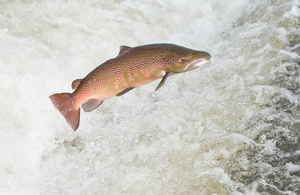New proposed measures announced ahead of salmon consultation
The Environment Agency is proposing new measures to protect salmon stocks across England and in the Border Esk

Environment Agency to tackle decline in salmon population
The Environment Agency is proposing new measures to protect salmon stocks across England and in the Border Esk, which are currently among the lowest on record.
The 2015 national salmon stock assessment indicated that salmon stocks in many rivers across England had failed to meet their minimum safe levels. The 2016 assessment showed this trend continued and the new measures proposed are based on this assessment.
The proposals come after an initial EA consultation last year to understand how the better management of salmon fishing in England and the Border Esk can reduce the impact on salmon numbers. The responses to that consultation helped inform these proposals and build an understanding of the likely impacts for managing salmon fishing in the future.
The Environment Agency is now proposing the following measures to protect salmon stocks in England Fisheries and on the Border Esk:
-
Stop the taking of salmon from the majority of net fisheries by 2019. Other nations have closed their net fisheries; the evidence shows we should too.
-
For rivers with the lowest salmon stocks, a mandatory requirement to return all salmon caught. This reflects the need for both net and rod fishermen to help us protect Salmon stocks.
-
Voluntary catch and release targets for all other rivers.
-
Restriction on the number, size and type of hooks that can be used when fishing.
Kevin Austin, Environment Agency’s Deputy Director for Agriculture, Fisheries and the Natural Environment said:
We are not suggesting these proposals lightly and have consulted widely with those affected. However we need to take action now in order to give as many of the salmon that make it back to our rivers as possible a chance to spawn successfully.
The reasons for the decline of salmon are complex, and there is no single solution; reducing the catch of salmon can only partly contribute to the recovery of salmon stocks. We continue to work closely with water companies and other partners to improve water quality and low flows on salmon rivers. We are also investing and working in partnership with companies and stakeholders to improve fish passage on schemes up and down the country.
It is only through continuing to take concerted action, and through the co-operation of others, that we will successfully protect this iconic species for future generations.
Reducing the taking of salmon by rods and nets is only one part of the Environment Agency’s larger programme called the ‘Salmon Five Point Approach’. The Salmon Five Point Approach has been jointly developed and committed to by a wide range of partners which include Government, Atlantic Salmon Trust, Angling Trust, River Trusts, Wild Trout Trust and the Institute of Fisheries Management.
It sets out the actions to address the key pressures that affect the different life stages of salmon. The priorities are:
- Improve marine survival.
- Further reduce exploitation by nets and rods.
- Remove barriers to migration and enhance habitat.
- Safeguard sufficient flows.
- Maximise spawning success by improving water quality.
You can find out more about the Salmon Five Point Approach.
We will formally advertise the proposed byelaws to protect Salmon and they will be published on GOV.UK in late February 2018. All those wishing to may respond either online or via letter.
Notes to Editors:
- The most vulnerable rivers will be the rivers classed as “At Risk”, as calculated in the national salmon stock assessments. These are: the Tees, Stour, Yealm, Plym, Ribble, Wyre, Lune Crake, Calder and Derwent.
- Voluntary catch and release levels at rivers classed “probably at Risk” will be required to be greater than 90%.
- Voluntary catch and release levels should be encouraged on rivers classed as ‘Probably not at Risk’.
- Other countries that have closed salmon net fisheries include, Eire, Wales, Scotland, Northern Ireland, Faroese fisheries.
- 2015 national salmon stock assessment.
- 2016 national salmon stock assessment.